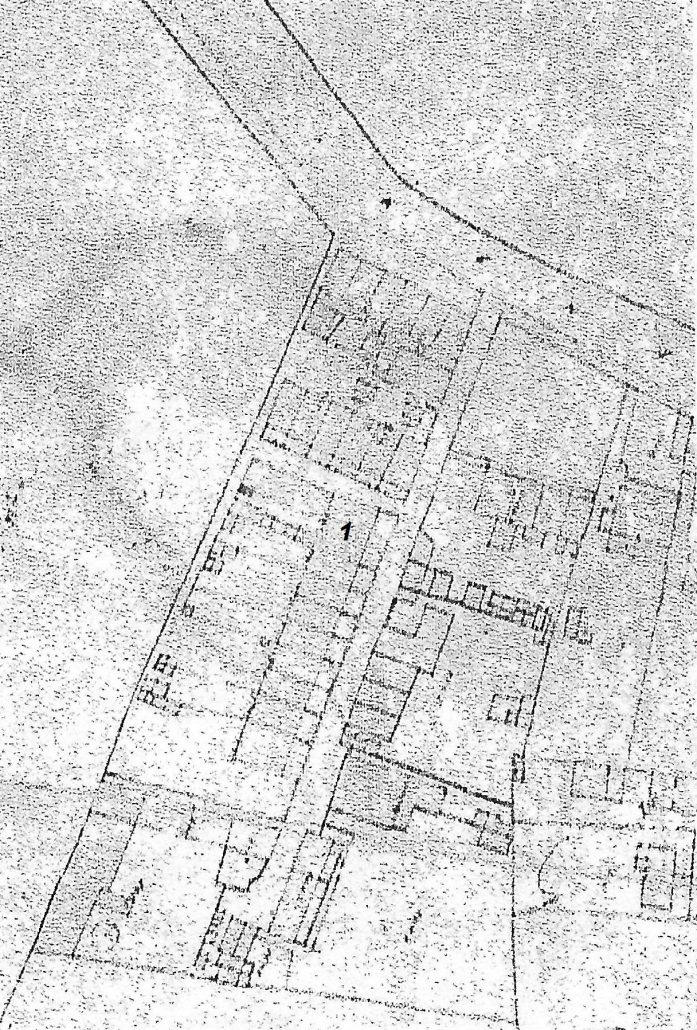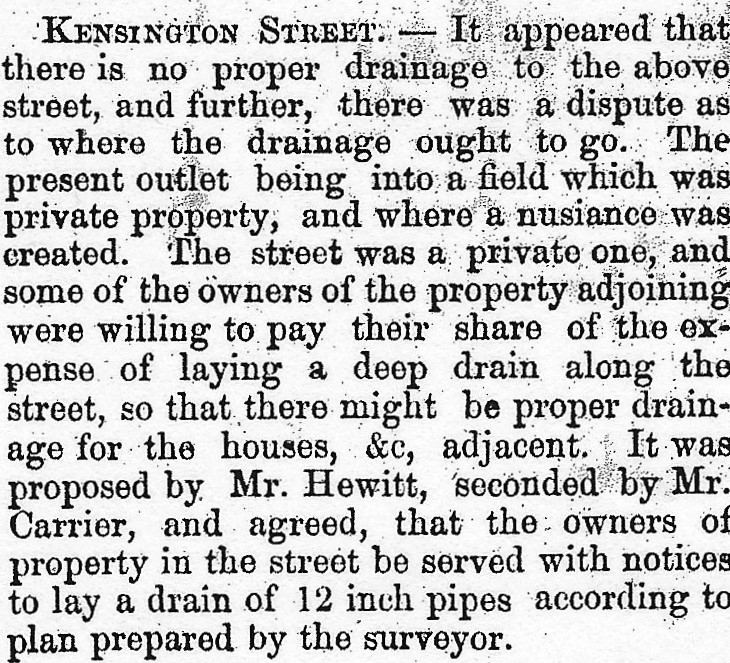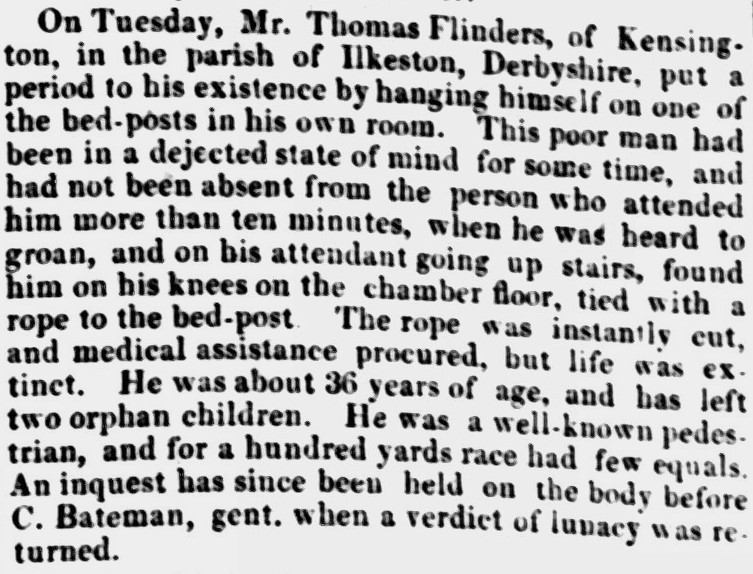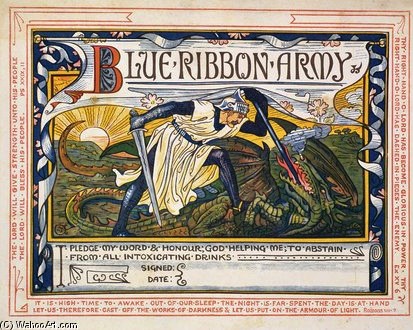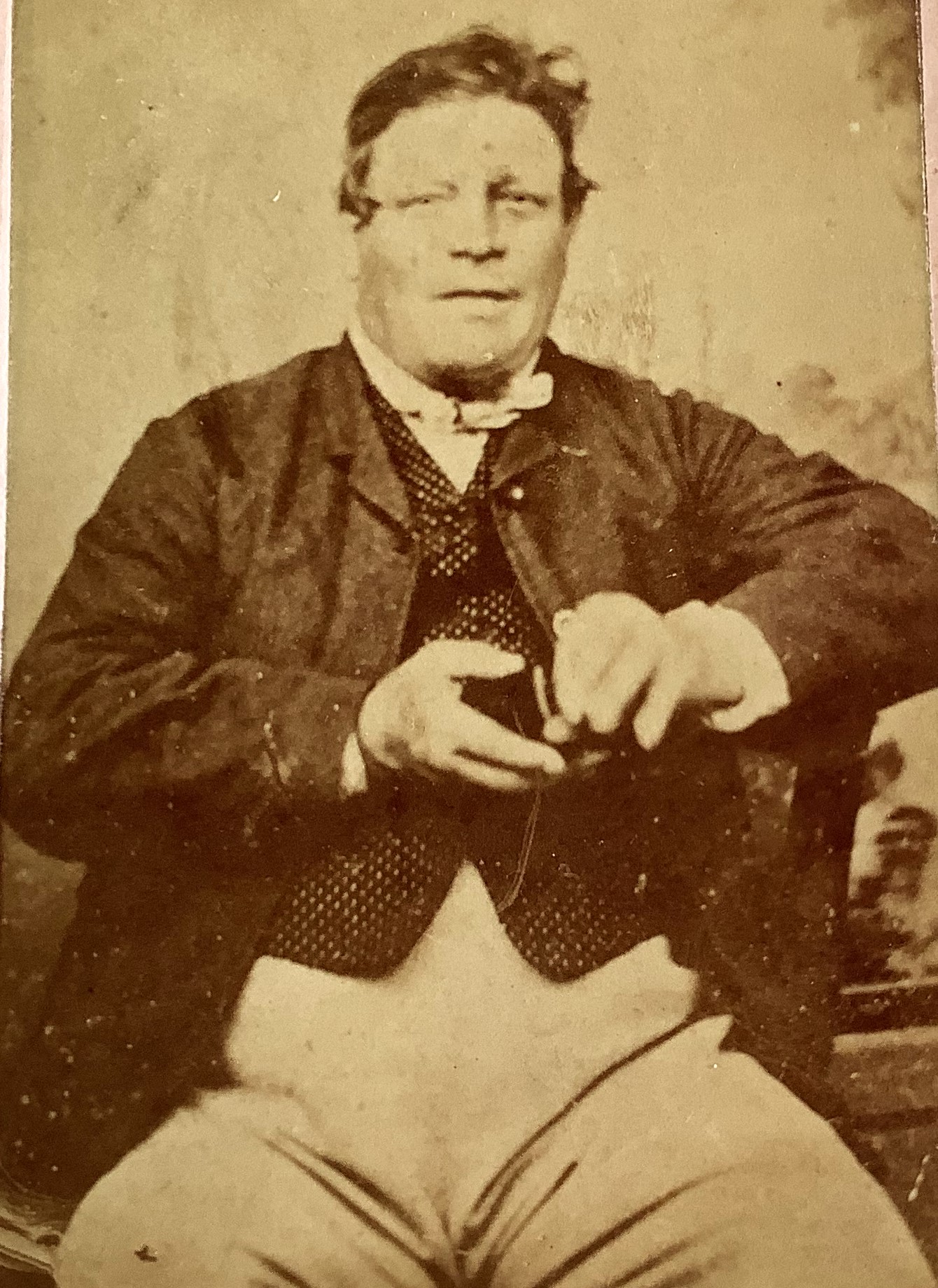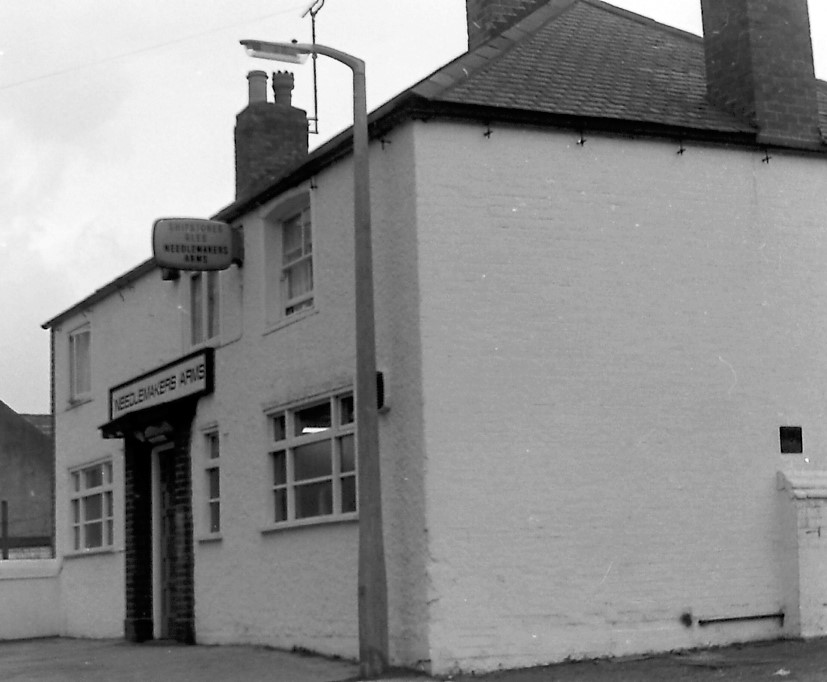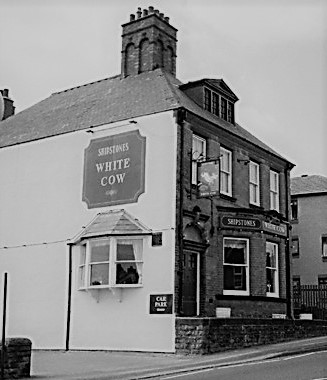Leaving the Mechanics’ Institute we come to two beerhouses in close proximity to each other.
The Lowe family at the Needlemakers’ Arms.
Adeline is not too well-acquainted with this area; “there was an old Inn down Hunger Hill, but unfortunately I forget the name.” This ‘old inn’ may have been White Cow beerhouse — or more probably the Needlemakers’ Arms which was in fact in Kensington Street.
One of the landlords of the latter establishment was Cossall-born Samuel Lowe, son of Richard, weaver and one time Cossall Parish clerk, and Frances (nee Bradshaw) and uncle of grocer Samuel Lowe of South Street.
Trade directories of the 1840’s and 1850’s refer to Samuel as a keeper of a beerhouse in Nottingham Road. It stood at the south-east end of a plot of land, previously part of Trowell Bridge Field,and the name was certainly used in the 1840s.
Samuel lived there with his first wife Sarah (nee Taylor), the daughter of Little Hallam framework knitter Samuel and Ann (nee Butler) until she died on October 2nd, 1843. Six months later and Samuel married widow Mira Stone (nee Burgoine) on March 31st, 1844.
In August 1858 he was granted a victualling licence, having kept that beerhouse in Kensington for the previous 20 years without a complaint against him. He was still there in 1865.
Samuel was an early bird, usually up and busy by about 4am, as was the case one Tuesday morning in 1865.
An hour after arising he returned upstairs to find that Mira had cut her throat. Dr. Norman was immediately called, successfully treated the wife who was then removed to the asylum at Mickleover for a time. A quarrel with a neighbour was thought to be the immediate cause of the attempted suicide although the Pioneer had no doubt that “she had been brought to a state of insanity through extreme drinking”.
Mira outlived Samuel by a dozen years. The former landlord died in Nottingham Road on January 31st, 1878, aged 78.
———————————————————————————————————————————————-
A dangerous neighbourhood ?
In December 1867, letter-writer ‘Jim‘ felt compelled to inform most of the populace of Ilkeston — or at least those who read the Pioneer — about this area.
He described what he had discovered as “one of the greatest evils of the town … Ilkeston is infested with a regular swarm of the lowest, beastliest, vilest characters that can be found in the world — women as have lost all decency, and as have sunk so low as to not scruple to use any means to carry on their devilish trade. They stand at the corners of the streets — they haunt the top of the cricket ground — but they are found in full bloom at Kensington and Hungar Hill. …. At one brothel on the Nottingham-road there is the most disgusting things going on every night…. they’s been about fifteen boys and young men drinking and smoking, and sometimes worse too, until four or five on Sunday morning. On Sunday afternoons and nights an’ all the house is chock full; little lads about 14 or 15 from agen us are always down there to spend their money when they’ve got it. ….. There is three or four more such like places in Kensington — one kept by a man named Shap (as is now in prison for stealing, …); he used to live in Grass-lane, but he was drove out of there, and then went down to Kensington. … At Hungar Hill, about four or five women live, as is either married or as keeps men on what they get in their diabolical trade. The misery and pain these places is causing you can’t tell. Just imagine how nice it was for them mothers as went the other morning at five o’clock, and fetched their boys from a awful house of ill-fame in Kensington. ….. There’s a certain public-house in Kensington as is always full on Sunday nights of Common chaps and good women. It’s a regular place for ’em to go to … I know nothing about the landlord, as he’s a stranger to the town (I think he comes from Nottingham), but I don’t think it does him much good to harbour such folks”.
If the public house mentioned by Jim is the Needlemakers’ Arms and the landlord referred to here is John Daykin, then he was from Sileby in Leicestershire. Certainly, by 1871, he kept the beerhouse with his wife Jane (nee Hutchinson).
The map (right) shows the site of the Needlemakers’ Arms in 1866 (No 1) …. my apologies for its poor quality. (.. the map not the Arms !!)
Nottingham Road is the one at the top and Kensington Street, a dead-end, leads off from it.
It should be noted that the street was designated as ‘private’, one that benefitted primarily owners of property in that street and was not therefore a thoroughfare.
As a consequence the owners had to pay to repair or improve it.
Had it been a thoroughfare, used by the public for some time, then it would be repaired at the public expense, by the Local Board.
Imagine what it might have been like, taking an evening walk along the street towards the ‘Needlemakers’ at its end, and worse still, stumbling out of the pub after a few pints and trying to make your way home in the dark … no tarmacked road or slabbed pavement then !!! (as pointed out in this report in the Ilkeston Telegraph, May 10th 1873).
From 1874 to 1876 the landlord of the Needlemakers’ was Henry Beardsley … though when his licence was renewed in September 1875 he was cautioned for previously selling liquor during prohibited hours.
By 1881 Herbert Tatham was ‘mine host’ and was still there in the summer of 1887 when the inn was put up for auction. At that time the Inn appears to have been owned by Edmund Tatham, eldest son of Benjamin and Sarah. He had recently died — on March 4th 1887 — and the trustees of his will put the premises up for sale by auction in August. It was sold for £1530 to the Carrington Brewery Company.
Herbert Tatham was a son of needlemaker Benjamin and Sarah (ne Hardy) and the uncle of the other Herbert who died in 1882, and while still landlord at the Inn he received a visit from Capt* Henry Stair Sandys, in the summer of 1884.
For many years the Captain had been the local Inspector of Weights and Measures and was often out and about, around the town, ensuring that local tradesmen and women complied with the law and were not ‘short-changing’ their customers. And he himself was never ‘short-changed’ when it came to catching traders breaking the law.
Henry’s visit to the Needlmakers’ Arms resulted in a visit by Herbert to the Ilkeston Petty Sessions a few weeks later. There he pleaded guilty to selling adulterated whiskey … adulterated that is with 8% water. He was fined 1s with 10s 6d costs. But he was not the worst offender caught by the Captain in his summer scourge.
Down at the bottom of Nottingham Road the Inspector had popped into the Horse and Groom, then licensed by John Trueman, but kept by his son-in-law Owen Bostock. There the added water was 9% and that little bit extra meant a larger fine of 5s for John!!
And up Nottingham Road and then right, into South Street was the Nag’s Head Inn where widow Sarah Turton had been licensee since the recent suicide of her husband Charles. After analysis the whiskey was found to have been ‘watered’ although Sarah argued that it could have evaporated while in its keg. Her ‘clean criminal record’ meant that she was fined much the same as Herbert Tatham.
John Hill at the Brunswick Hotel tried the same defence argument as Sarah but as the level of added water was 12% he suffered a greater fine … 5s and 10s 6d costs.
But the worst offender was found at the Three Horse Shoes where landlord John Harvey also ‘welcomed’ the Captain. Here the added water was shown to be 24%, making the whiskey 49° under proof. John declined to appear at the Petty Sessions when a fine of 10s with 12s 6d costs was slapped on him.
*Henry Stair Sandys was styled ‘Captain’ because he was a retired Royal Navy captain.
In February 1891 Herbert’s licence was transferred to William Beer (!!) — the address of the Inn was then 12 Kensington Street, while a few years earlier it was number 15. In July 1893 William surrendered the licence to Edward Worton who came from the Victoria Inn on Awsworth Road. The latter was still there in 1896, though his wife was not !! … having left Edward a few years earlier.
A faulty census … again !!
Going back to letter-writer Jim (above), I wonder what he would have made of the family living at number 15 in 1891. If you look at the census for that year, you will see that it is occupied by breaksman Samuel W. Hudson, his wife Sarah, and their eight children, ages 20 to one month. However this entry hides many subtleties and several errors.
‘Sarah‘ was born Sarah Cook on February 26th, 1851, at Little Hallam, the daughter of ironstone miner Samuel and Elizabeth (nee Smith). On October 7th, 1870, she gave birth to illegitimate son, John James Fritchley Cook — he is the first child on the 1891census, named as ‘John Hudson‘. Then, on December 26th, 1876, Sarah married lacemaker John Hudson, who fathered the next five children on the census list. John died in 1884, aged 27, and Sarah then found a partner in Samuel Wright — he is ‘Samuel W Hudson‘ on the census. There was no marriage but there were two illegitimate children, William Wright Hudson (born on November 6th, 1888, at Pimlico), and Joseph Wright Hudson (born on March 19th, 1891, at 15 Kensington Street); these are the last two children on the census.
A little over three months after the census was taken, infant Joseph died at the house he was born in. He had always seemed an unhealthy infant, thin and emaciated, though was not showing any signs of illness when, on one Thursday night, his mother took him into her bed as usual — a bed she shared with another child and Samuel Wright. When she awoke at about six in the morning her son was dead, dressed in his old petticoat and a little shirt. At the following inquest, the Coroner was particularly critical of Sarah and of the way she was living — it wasn’t at all creditable to her. She had provided for the child, as much as she could, though he still found time to attach some blame to her for Joseph’s death. She could have kept him cleaner, and was setting a bad example to her other children by the way she lived. He strongly advised Sarah to get married !!
Sarah appears to have ignored this advice. She died, as Sarah Hudson, in 1906 (I believe)
————————————————————————————————————————————————
The Flinders family at the White Cow.
Adeline remembers “another (beerhouse occupied) by the Flinders” and this would be the White Cow, opposite was to be the site of Kensington Board Schools. It was 70 Nottingham Road in 1871.
Benjamin Flinders, needlemaker later publican, was the son of lacemaker Thomas and Elizabeth (nee Brentnall) and was another resident who lived for most of his adult life in the Nottingham Road area. His father had married twice and Benjamin was the child from the first marriage. On October 11th, 1812 his father had married Elizabeth Beardsley Brentnall, a daughter of farmer William and Sarah (nee Beardsley), but she had died in Febryuary 1817, just a short time after the birth of Benjamin. Benjamin’s father then married Mary Attenborough on November 11th, 1821, and there were three more children from that marriage, before Mary died in July 1828. Perhaps her death left Thomas depressed, feeling forlorn ? On September 9th, 1828 Thomas committed suicide.
Nottingham and Newark Mercury (September 13th, 1828)
Thomas was aged 41 and his two orphaned children would be Benjamin, and Thomas, born in June 1826 and who died of cholera, May 11th, 1840.
On December 27th, 1842 Benjamin married Dale Abbey-born Mary Taylor, the daughter of farmer Samuel and Hannah (nee Blower) and then lived in the Hunger Hill or Kensington district of Nottingham Road. From about 1860 he was proprietor of the White Cow beerhouse there — a beerhouse since about 1826.
The previous keeper had been James Gould, born at Castle Bromwich, then in Warwickshire – and who also appears in registers and in the census as ‘Gold’ and ‘Gouldingay’. He retired from the trade about April 1858, through ill-health.
James died on May 16th, 1862, as ‘Gould’, in Hungerhill, aged 87.
In September 1874 Benjamin’s application for a victualler’s licence was refused, as it was in 1875.
In September 1876 he applied again. Now he argued that there was more of a need for a licence as 67 houses had been built in the neighbourhood in the last two years, 25 within the last year. Again he was refused.
And again he was refused in 1877.
And again, in 1878 — despite the appearance of another 60 new houses in the vicinity within the last year.
And despite the fact that the population of Ilkeston had doubled in the last 12 years, the magistrates had granted no new indoor wine and spirit licences in that time.
When Benjamin died at the White Cow on September 22nd, 1879, his widow took over the beerhouse’s licence, assisted by her niece Mary Ann Bloor, daughter of David and Priscilla (nee Taylor).
Mary succeeded where Benjamin had failed — she was granted a victualler’s licence in August 1885 … opposed only by the Ilkeston Temperance Society and the Blue Ribbon Society, which had extended its influence from America to Britain in the early 1880’s. “It appeared to oppose everything” remarked the Derbyshire Advertiser at the time.
Mary Flinders died at the White Cow on April 17th, 1893. The licence was the transferred to William Beer who promptly secured a music licence for the White Cow, though not for the premises’s clubroom. William didn’t last long, and in December 1893 he departed for the Horse and Groom and in came Walter James Parsons. In March 1895 Walter left to keep the beer-off in North Street which Samuel Wood had just left (though within four months Samuel was back at North Street). In Walter’s place at the White Cow arrived Richard Greaves, from the Clarendon Hotel in Derby. But as with the previous tenants, Richard’s tenure was short-lived and in June 1897 and he gave way to Herbert Woodhouse. Herbert’s licence was renewed in August 1898 even though he had recently been convicted of selling adulterated rum. Meanwhile Richard Greaves left to start a butcher’s business in Nottingfham but by May 1899 he was bankrupt.
Born in 1842, the son of Benjamin and Mary, needlemaker Samuel Flinders also seemed attached to this area.
Samuel Flinders (1842-1916), a needlemaker all his working life (courtesy of great great grandson Chris Willis)
He lived most of his life in either Nottingham Road or Regent Street and died in Hunger Hill Yard in March 1916.
His wife Eliza (nee Spencer), the daughter of Nottingham Road/Regent Street lacemaker Hillary and Selina (nee Bell), died at 15 Dale Street, the home of their only daughter Sarah and husband Frank Hobson, son of Matthew and Jemima (nee Grammar) whom we met in the Market Place.
Daughter Hannah’s marriage to licensed victualler Edwin Hall in February 1882 took her further afield.
For most of the next decade Edwin was landlord at the Sir John Warren Inn in the Market Place while Kelly’s Directory of 1891 lists him at ‘the Rutland Hotel and headquarters of the Ilkeston Bicycle Club’.
They were together there almost until the end of the century when Edwin died at the hotel in 1898, aged 53.
Hannah continued alone.
Traffic Alert !! January 21st 1892
Samuel Quinton, a carter of 10 Nottingham Road, fancied a pint at the White Cow before returning home. So he popped into the beerhouse — only for 25 minutes you realise ? However the Law was on hand to summons him for leaving his horse and cart outside, unattended and wandering around. Fortunately for Samuel, the magistrates were in a forgiving mood and let him off with a caution, to be more careful in future.
——————————————————————————————————————————————————
The two inns in later life, before converted to other use.
———————————————————————————————————————————————–
We now pause at Hunger Hill to consider the background to one of its inhabitants … the Frost family .. with the considerable help of contributor Alan Smith.
Or we could continue down Nottingham Road ?

